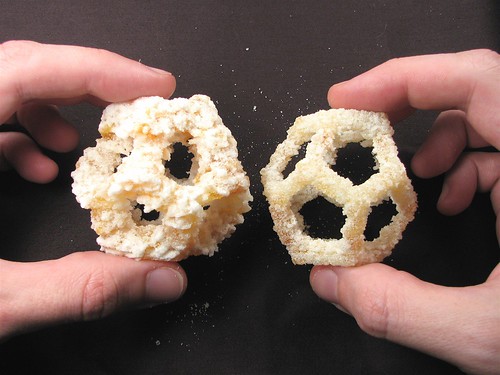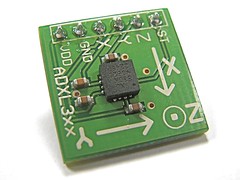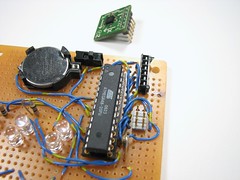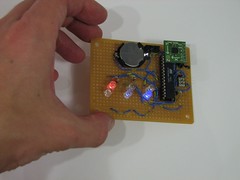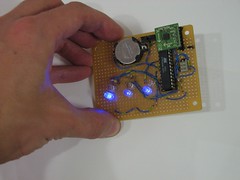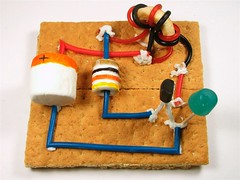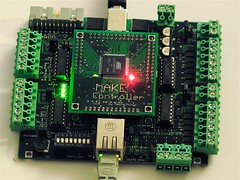Over at candyfab.org, things are getting sweeter all the time. Link.
Category Archives: Engineering
Matt’s awesome chip desk

What does one do 434 discarded Itanium CPUs? Matt Tovey was inspired by our Chip Trivet, and used them to make this awesome computer desk.
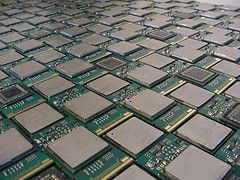

The CPU modules were scrapped as the result of a supercomputer upgrade, and were presumably functional before having their heat sinks taken off– a herculean effort for that many CPUs! Matt says that the list price for the lot of chips was over US$800,000 in 2006 and that the desk contains about 2.8 TFLOPs of computing power, about the same
as 900 3.2GHz P4s.
Matt started with a plain desk, tiled in the CPUs, and added wooden edging and a beveled glass top. Nice work!
I just love the way that this desk looks. But it gives me an idea too– take it one step further, and what if it worked? You could use a single, giant PCB for the motherboard which sat underneath the glass surface of the desk. With that much area, you could fit in a lot of processing power. On the cheap (or moderately cheap), one could imagine instead filling the inside of a desk top with low-cost (even last-generation) PC motherboards to make a great looking beowulf cluster or render farm that doesn’t take up any desktop or rack-mount space.
Sadly, Matt’s page has moved on to the great /dev/null in the sky, but the mirror still shows some of the build photos.
Using an ADXL330 accelerometer with an AVR microcontroller
The last decade has seen more than an order of magnitude drop in the price of
accelerometers, devices capable of measuring physical acceleration (often in more than one direction). History suggests that whenever a useful technology makes a precipitous drop in price, unexpected applications follow, and that’s exactly what has happened in this case.
Starting from zero and summing up acceleration, you can use an accelerometer to find velocity, and from that derive relative position information. By measuring the acceleration due to gravity, one can also determine orientation (technically, inclination)– you can tell which way it’s pointing. Those are pretty useful skills for a chip! And so as bulk prices for tiny chip-scale three-axis accelerometers have begun to approach $5, they have started to appear in all kinds of mass-market applications that you might not have predicted: laptop computers (for hard drive protection), smart phones and cameras (for orientation– e.g., portrait vs. landscape on the iPhone), cameras for image stabilization, and quite visibly in the controllers for Nintendo’s Wii system.
With all that promise, you might think that an accelerometer is a difficult beast to harness. That turns out not to be the case. In this little project we demystify the mighty accelerometer and show you how to get started playing with one. In the spirit of hobbyist electronics we do this the easy way– without designing a PCB or even soldering any surface-mount components.
Note: An updated version of this article is now available here.
Continue reading Using an ADXL330 accelerometer with an AVR microcontroller
CandyFab @ Dorkbot: 8/15/07 @ TechShop
On Wednesday, August 15 we’ll be giving a presentation about CandyFab at a meeting of Dorkbot SF, our local spinoff of
Dorkbot NYC.
Dorkbot chapters organize monthly talks and events for artists, scientists, and engineers centered around the theme of “the creative use of electricity.”
The meeting will be held at 7:30 PM at TechShop, a San Francisco Bay Area “open-access public workshop,” located just off of 101 in Menlo Park, where you can go use a wide range of tools and machines to make things. We’ll be bringing the CandyFab machine along, and– if everything goes right– demonstrating its use. So if you’re in the SF bay area, this is a great chance to come and take a close look at the CandyFab 4000, smell the caramel, and ask questions. Besides our talk and demo, there will be a couple of shorter presentations on other dorkbot-ish topics, and an introduction to TechShop. (Tours of Techshop will be available at the end of the meeting as well.)
Everyone is welcome to come to the meeting; there is a $5 suggested donation for the venue at the door.
[Link] See you there!
UPDATE: The event was great! (Read more here.)
More circuitry snacks
My old friend Kevin sent in these pictures of a massive array of tasty electronic treats that he and his family made for a group picnic at Los Alamos National Laboratory. (Nice work!) If your diet is short on precision op-amps and instrumentation amplifiers, these just might hit the spot.
You can read our own article about circuitry snacks (dated July 11, 2007) here.
Printing complex shapes: A sugar chain
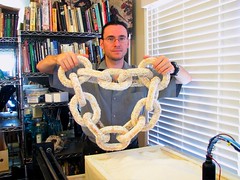 We made this chain of twelve giant links on the CandyFab 4000 to demonstrate the fabrication of a complex object, the sort that is difficult to make by conventional machining processes. You can see the 3D model and some build pictures for this monstrosity over at CandyFab.org.
We made this chain of twelve giant links on the CandyFab 4000 to demonstrate the fabrication of a complex object, the sort that is difficult to make by conventional machining processes. You can see the 3D model and some build pictures for this monstrosity over at CandyFab.org.
This object also highlights the relatively large build envelope of the CandyFab– significantly larger than that of most other low end (i.e., under $50k) 3D fabrication systems.
PS for Chemistry geeks: insert joke about long-chain hydrocarbons here.
CandyFab.org : The CandyFab Project
Today we are spinning off one of our projects and launching a new web site: CandyFab.org. The new site is intended to help foster a community around the idea of accessible, low-cost, and open-source three-dimensional fabrication technologies.
The first major goal of The CandyFab Project is to completely re-engineer the CandyFab within the coming year. We plan to produce an open reference design in hardware and software for what will become the CandyFab 5000S– a low-cost solid freeform fabrication machine that can be built with commercial off-the-shelf parts.
If you’d like to participate in designing, constructing, or using machines like this, we’d love to hear from you. Hop on over to CandyFab.org.
Five Electronics Tools You Might Not Know About
You’ve got your wire strippers and your soldering iron…now what? You probably know that there is a standard set of essential tools that you need on your electronics workbench. You can find helpful lists of these tools at Lady Ada’s site and Dan’s Data.
However, real tool junkies always want just the right tool for the job. Here are five electronics tools you may not know you were missing. These esoteric tools go a bit beyond the basics that everyone should have.
Continue reading Five Electronics Tools You Might Not Know About
Circuitry Snacks
Here we present what is arguably the tastiest way to design and learn about electronic circuits: make circuitry snacks!
Two of our favorite things in the world are playing with electronics and playing with food, and so it is about time that someone finally got around to combining the two. We begin by gathering up appropriate snack-food building blocks and making food-based models of electronic components. From these components, you can assemble “circuitry snacks”– edible models of functioning electronic circuits. You can make these for fun, for dessert, for your geek friends, for kids, and for teaching and learning electronics.
Continue reading Circuitry Snacks
Class Reminder: Choosing a Microcontroller (Sat 7/7 @ TechShop)
Tomorrow I’ll be again giving my seminar called “Choosing a Microcontroller” at TechShop. This class is a broad introduction to the capabilities and variety of single-chip computers, as well how to actually pick one for a given application. It’s easy to get overwhelmed looking at the variety of range of micros, from four-bit micros that have a 4-bit wide data path — and actually cost four bits— to AVRs and PICs, basic stamps and Arduinos, to 32-bit gorillas with names like ARM, Blackfin, and Coldfire. So, we’ll try and cut through the fog and help you figure out where to get started.
If you’ve heard people getting excited about or doing cool things with microcontrollers and want to learn more, this might be a great introduction to the field.
Sign up for the class here.
If you are interested in the topic but can’t make it, you might want to take a look at our
list of resources for choosing microcontrollers.
This is the last time that this particular class will be offered in the near future. Another intro AVR class will be forthcoming, probably in August. As always, if you have other ideas for classes that are within our expertise, please let us know.




